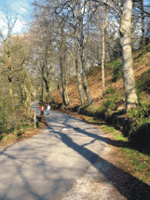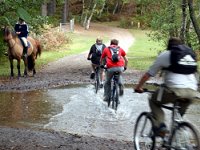Responsibilities
 The following information is intended to be a guide, the document below includes further information.
The following information is intended to be a guide, the document below includes further information.
Please do not hesitate to contact us if you cannot find what you need.
User rights and responsibilities
The public's right over a highway is a right of passage. Path users must keep strictly to the line of the path and must not loiter.
On public rights of way, you can:
- Take a pram, pushchair or wheelchair if practical
- Take a dog (on a lead or under close control)
- Take a short, reasonable detour to get round any illegal obstruction.
Wherever you go, do not forget the Country Code.
Our role
We, as the highway authority, is responsible for the maintenance of public rights of way. A parish council has the power to maintain footpaths or bridleways in its area, but this does not remove responsibility from the highway authority.
We should:

- keep the surface of the public path network in good repair and control vegetation (other than crops) growing from it
- maintain bridges over natural water courses, including farm ditches
- signpost rights of way from metalled roads and provide additional signs and waymarks as necessary along the route
- protect the public's right to use and enjoy rights of way
- secure the removal of obstructions, including ensuring that paths over cultivated land are reinstated and marked out after they have been disturbed
- ensure that there are no intimidating notices that would deter the public from any paths
- provide a minimum 25% contribution towards any costs incurred by a landowner in maintaining stiles or gates on public rights of way
The landowner's role
The landowner or occupier of land must:
- keep rights of way clear of obstructions
- cut back vegetation encroaching from the sides and overhanging the path, so that it does not inconvenience the public or prevent the line of the path from being apparent on the ground. (On bridleways, horse riders should be allowed 3 metres [10 feet] of headroom)
- ensure that all field-edge public paths are never cultivated
- ensure that cross-field footpaths and bridleways are cultivated (i.e. ploughed or disturbed) only when it is not convenient to avoid them and are properly reinstated after disturbance
- keep paths clear of crops to ensure that they do not inconvenience users
- maintain any stiles or gates on a public path in a safe condition
- ensure that bulls are not kept in a field crossed by a path unless they do not exceed 10 months old or are both not of a recognised dairy breed and are accompanied by cows or heifers
- ensure that any warning notices are displayed only when a bull is present in a field
- never keep any animal which is known to be aggressive in a field to which the public has access
- ensure that no misleading signs are placed near rights of way that might discourage access.
Most landowners fulfil their legal responsibilities with regard to rights of way. For the small minority of landowners that do not comply with their statutory duties, formal action, including prosecution may be taken.
The Parish Council's role
Parish councils have no specific duties for rights of way, however, they are given certain powers which can help the public to enjoy the public path network.
Parish councils can:
- maintain any footpath or bridleway within its area which is maintainable at public expense
- erect lighting on any footpath or bridleway. Although the number of public paths likely to require lighting is small, lighting can be important on paths leading to a village or bus stop for example
- erect notices, with the consent of the landowner, on or near a footpath or bridleway, warning of local dangers
- create new footpaths and bridleways by agreement with the landowner over land in their own and adjoining parishes if satisfied that the creation would be beneficial to all or, any part of, the parish or community
- signpost and waymark public paths on behalf of, and with the consent of the highway authority. A highway authority can give permission for other persons such as parish councils to erect and maintain signposts on its behalf
- provide seats and shelters at the side of public paths